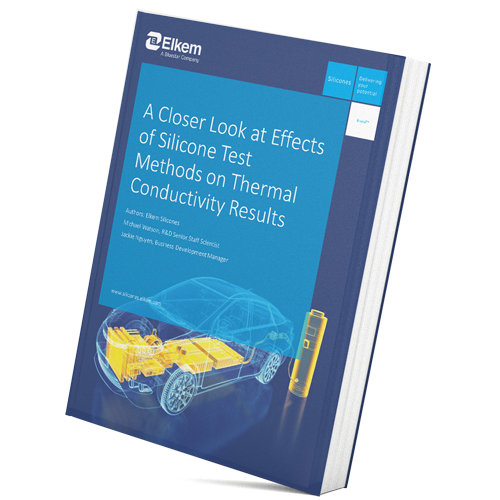- How to test thermally conductive materials for EV battery ?
How to test thermally conductive materials for EV battery ?
In their overall approach to improving the performance of electric vehicles (EV) and extending battery longevity, automotive manufacturers have focused on two main cooling options: active and passive cooling.
One option for thermal management in passive cooling systems uses thermally conductive silicone materials for heat dissipation. However, there are several different methods on testing thermal conductivity using various industry standards.
Engineers need to be aware of the most adequate thermally conductive materials, as well as how to test them to assess performances. This is an essential step to each battery pack design for Electric Vehicle (EV), Hybrid & Electric Vehicle (HEV) and Plug-in Hybrid Electric Vehicle (PHEV).
Here are some fundamental aspects battery engineers must examine: Temperature Range, Elasticity, Modulus, Mechanical Strength, Adhesion Strength, UV Resistance, Fire Resistance, Dielectric Stability, Coefficient of Thermal Expansion, Volatile amount
Testing is a very critical and technical exercise that involves covering a wide range of parameters. To help designers, manufacturers, and decision-makers, Elkem Silicones published a comprehensive White Paper on testing methods and procedures entitled Effects of Silicone Test Methods on Thermal Conductivity Results.
Please take the time to read a quick summary of different standardized thermal conductivity testing techniques.
Heat dissipation is critical for electronics and batteries to function for their intended lifetime and to enable them to reach the desired levels of performance and reliability in EV and HEV applications throughout their intended lifecycle. There is a lot of research and development in battery technology but one of the most common types of battery is lithium-ion based systems. Regardless of chemistry and cell design choice, proper thermal management to prevent thermal runaway or overheating during charging and discharging is critical to ensure safety and battery longevity. Temperatures of the internal and external cell to pack should stay uniform between 15°C and 35°C using various thermal management systems (TMS) including active or passive cooling formats:
- Liquid cooling
- Direct refrigerant cooling air cooling
- Thermo-electric cooling.
Knowledge of thermally conductive materials and the best option to evaluate their performances is the key to determine how well these materials will perform in a specific application (nb: your battery pack design!).Thermal Interface Materials (TIMs) play a key role in the effectiveness of the TMS to ensure efficient conductivity by filling air gaps and reducing interfacial thermal resistance between the TMS and heat generation or heat insulation of electric components. A good solution supplier should work closely with end-users to determine the materials best suited for the intended application, providing expertise to control the entire value chain from silicon metals to silicone adhesives and to design and provide customized and scaled systems.
It is important to work with suppliers having full control of their technology value chain, with strong expertise and broad offer. For instance, the Elkem Silicones portfolio includes thermally conductive silicone products, with liquid (or pasty) gap fillers, low viscosity thermally conductive options (like potting materials), with varying adhesion strengths and the tests associated to these. Our teams work directly with customers to identify the testing correlations with specific test equipment and methods
As an example to measure the Thermal Conductivity, we recommend the Thermtest Hot Disk Method (TPS) using ISO/DIS 22007-2.2 test standard.technologies.
To better orient Battery Engineers on the most appropriate test method for their thermally conductive materials, we’ve been running triplicate testing on the exact same product. Surprisingly, these results show differences in thermal conductivity of 20% or higher depending on the test conditions. This highlights the need to work closely with your material supplier to determine together which test method is best suited to reflect the real condition of your application. Read more about this topic in our White Paper Effects of Silicone Test Methods on Thermal Conductivity Results, including a case study on a customer application and the different results we had depending on test methods and equipment.
